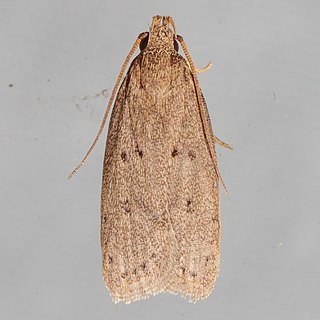
Scotorythra is a genus of moths in the family Geometridae erected by Arthur Gardiner Butler in 1883. All species of this genus are endemic to Hawaii.

The Autostichinae are a subfamily of moths in the superfamily Gelechioidea. Like their relatives therein, their exact relationships are not yet very well resolved. The present lineage was often included in the concealer moth family (Oecophoridae), but alternatively it is united with the Symmocidae sensu stricto to form an expanded family Autostichidae.

Stoeberhinus testaceus, the potato moth, is a gelechioid moth, supposedly the only species of its genus Stoeberhinus. However, the genus might also include some related moths presently placed in Autosticha. It belongs to the subfamily Autostichinae, which is either placed in the concealer moth family (Oecophoridae), or in an expanded Autostichidae.

Autosticha is a genus of gelechioid moths. It belongs to the subfamily Autostichinae, which is either placed in the concealer moth family (Oecophoridae), or in an expanded Autostichidae. It is the type genus of its subfamily. Originally, this genus was named Automola, but this name properly refers to a fly genus in family Richardiidae.
Brachmia opaca is a moth in the family Gelechiidae. It was described by Edward Meyrick in 1927. It is found in China and Taiwan.
Autosticha phaulodes is a moth in the family Autostichidae. It was described by Edward Meyrick in 1908. It is found in Sri Lanka.
Autosticha dayuensis is a moth in the family Autostichidae. It was described by Kyu-Tek Park and Chun-Sheng Wu in 2003. It is found in Jiangxi, China.
Autosticha taiwana is a moth in the family Autostichidae. It was described by Kyu-Tek Park and Chun-Sheng Wu in 2003. It is found in Taiwan.
Autosticha pachysticta is a moth in the family Autostichidae. It was described by Edward Meyrick in 1936. It is found in Korea, Japan and Sichuan, China.
Autosticha auxodelta is a moth in the family Autostichidae. It was described by Edward Meyrick in 1916. It is found in Assam, India.
Autosticha ansata is a moth in the family Autostichidae. It was described by Edward Meyrick in 1931. It is found in Chennai, India.
Autosticha euryterma is a moth in the family Autostichidae. It was described by Edward Meyrick in 1920. It is found in Kenya.
Autosticha guttulata is a moth in the family Autostichidae. It was described by Edward Meyrick in 1925. It is found in China.
Autosticha nothropis is a moth in the family Autostichidae. It was described by Edward Meyrick in 1921. It is found in South Africa and Zimbabwe.
Autosticha perixantha is a moth in the family Autostichidae. It was described by Edward Meyrick in 1914. It is found in Mozambique.
Autosticha tetragonopa is a moth in the family Autostichidae. It was described by Edward Meyrick in 1935. It is found in China and Japan.

Autosticha kyotensis, the Kyoto moth, is a moth in the family Autostichidae. It was described by Shōnen Matsumura in 1931. It is found in Japan on the island of Honshu. It is an introduced species in the United States, where it has been recorded from Alabama, Florida, Louisiana, Mississippi, North Carolina, Tennessee and Texas.
Anadasmus is a genus of moths in the subfamily Stenomatinae.




